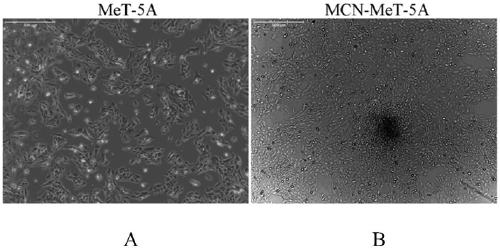Multiwalled carbon nanotube induced human pleural mesothelial cell malignant transformation strain and application thereof
A technology of skin cells and transformed strains, applied in the fields of biology and oncology, can solve problems such as difficult malignant transformation and stimulation, and achieve good application prospects
- Summary
- Abstract
- Description
- Claims
- Application Information
AI Technical Summary
Problems solved by technology
Method used
Image
Examples
Embodiment 1
[0023] Fiber preparation: MWCNT was purchased from sigma company, No. Aldrich 659258. When in use, weigh 5 mg of MWCNT powder and dissolve it in 1 ml of M199 culture solution to make a 5 mg / ml mother solution, and ultrasonically treat it in ice water to form a uniform suspension. Ultrasonic conditions: 180W, 10s on, 5s off, a total of 30 cycles. Autoclave after sonication.
[0024] Cell culture: Human pleural mesothelial cells (MeT-5A) were cultured in M199 medium containing 10% fetal bovine serum at 37°C, 5% CO 2 Cultured in a saturated humidity environment, the cells were subcultured once every 4-5 days, and inoculated at a ratio of 1:4. Cells were divided into treatment group / transformation group and blank control group, and each group had 3 wells for parallel control.
[0025] Transformation experiment: cells in the logarithmic growth phase were digested with 0.25% trypsin, counted after being dispersed by pipetting, and diluted to 1-2×10 5 Cells / well were seeded on 6-...
Embodiment 2
[0030] Cell apoptosis was detected by flow cytometry.
[0031] The MeT-5A and MCN-MeT-5A cells were subcultured until the monolayer was confluent, digested with trypsin, collected in a centrifuge tube, centrifuged at 1000g for 5min, discarded the culture medium; then suspended and washed the cells with PBS, centrifuged at 1000g for 5min After the cells were resuspended with 500 μl of binding buffer, 15 μl of Annexin V-FITC / PI was added and left at room temperature for 5 minutes; finally, flow cytometry analysis was performed. The results showed that, compared with MeT-5A cells, MCN-MeT-5A cells showed resistance to apoptosis after MWCNT exposure for 12 months. However, when MWCNT was exposed to poison for 6 months, the early apoptosis rate and the total apoptosis rate of the cells were significantly increased ( Figure 5 ).
Embodiment 3
[0033] Cell cycle changes were detected by flow cytometry.
[0034] MeT-5A and MCN-MeT-5A cells were subcultured to monolayer confluence, digested with trypsin, collected in centrifuge tubes, centrifuged at 1000g for 5min; suspended and washed in PBS twice, centrifuged at 1000g for 5min and collected; Re-suspend cells in 0.3ml PBS to avoid cell clumping; add pre-cooled pure ethanol at a ratio of 70-75% of the final concentration, and fix for at least 2 hours; centrifuge at 1000g for 5 minutes, discard ethanol; suspend and wash the cell pellet in 1ml PBS, and place Centrifuge at 1 000 g for 5 min for 1 min; suspend the cell pellet with 500 μl PI / Triton X-100 staining solution, place at 37°C for 15 min, and then use flow cytometry for detection.
[0035] Table 1 Changes of MCN-MeT-5A cell cycle
[0036] cell name
[0037] The results are shown in Table 1. Compared with MeT-5A cells, MCN-MeT-5A cells increased in G1 phase and decreased in S phase.
PUM
 Login to view more
Login to view more Abstract
Description
Claims
Application Information
 Login to view more
Login to view more - R&D Engineer
- R&D Manager
- IP Professional
- Industry Leading Data Capabilities
- Powerful AI technology
- Patent DNA Extraction
Browse by: Latest US Patents, China's latest patents, Technical Efficacy Thesaurus, Application Domain, Technology Topic.
© 2024 PatSnap. All rights reserved.Legal|Privacy policy|Modern Slavery Act Transparency Statement|Sitemap



